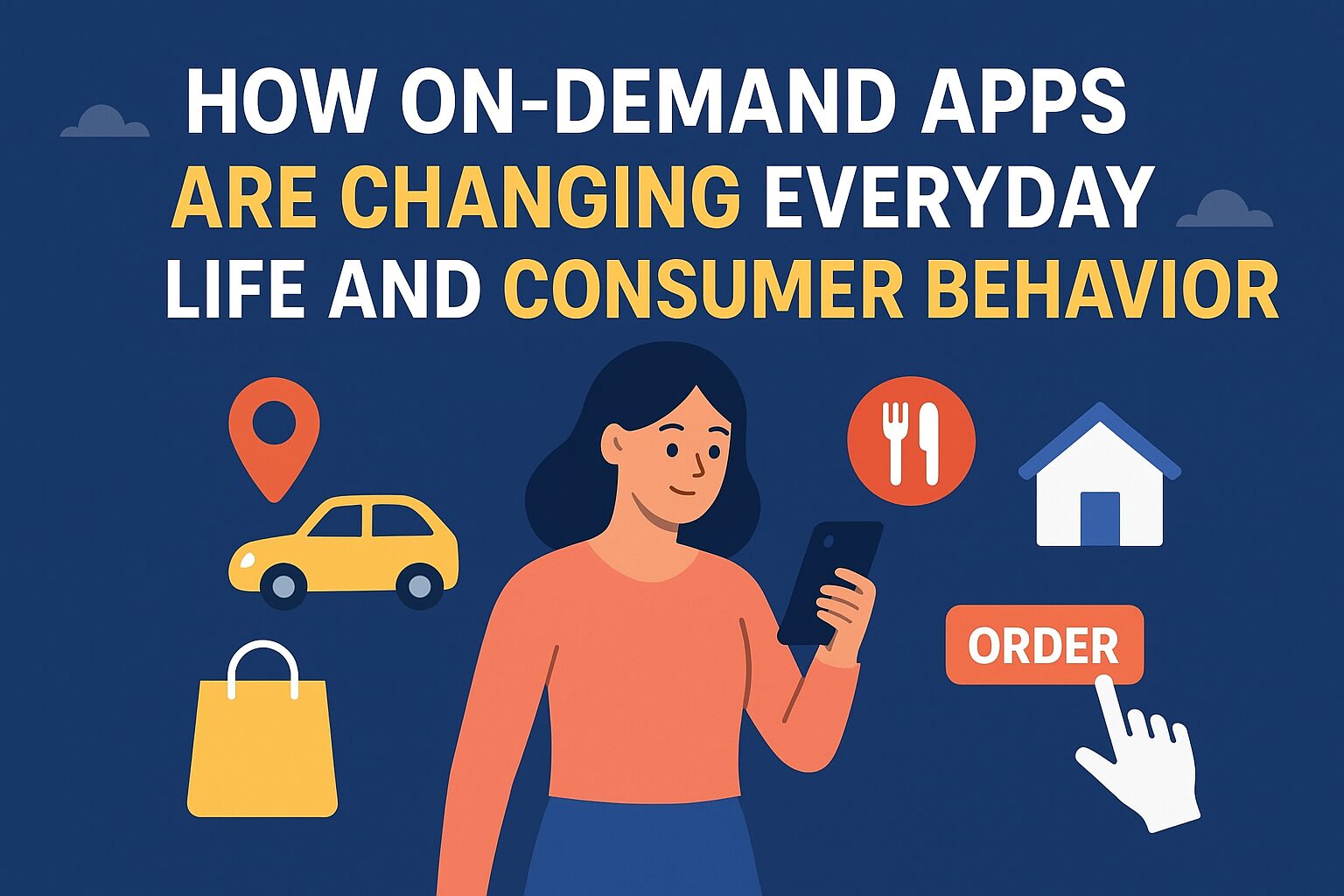In the last decade, technology has reshaped the way people live, work, and interact. Among these innovations, on-demand apps have emerged as game-changers, influencing not only business models but also everyday life. From ordering groceries to booking a ride or scheduling a home service, on-demand apps have become integral to modern consumer habits. This article explores how on-demand apps are transforming daily routines, influencing consumer behavior, and redefining expectations in various industries.
What Are On-Demand Apps?
On-demand apps are mobile or web applications that provide instant access to goods or services with minimal friction. They connect service providers with consumers in real-time, often leveraging GPS technology, digital payment systems, and user-friendly interfaces. Examples include Uber for transportation, Instacart for grocery delivery, and TaskRabbit for home services.
The core feature of on-demand apps is immediacy, enabling users to request a service and receive it quickly, conveniently, and reliably.
The Rise of On-Demand Apps
Several factors have fueled the growth of on-demand apps:
- Smartphone Penetration: Widespread smartphone adoption has created an ecosystem where apps are the primary tool for accessing services.
- Changing Consumer Expectations: Modern consumers prefer convenience and speed, seeking services that fit their lifestyle rather than adhering to traditional business hours.
- Technological Advancements: Cloud computing, mobile payment systems, GPS tracking, and AI-driven algorithms have made real-time service delivery efficient and scalable.
- Cultural Shift Toward Sharing Economy: Consumers are now more willing to share resources and access services on-demand rather than owning or investing in them directly.
How On-Demand Apps Are Changing Everyday Life
On demand app development has revolutionized the way services are delivered, creating apps that make daily tasks faster, easier, and more convenient than ever. On-demand apps are not just a convenience—they are fundamentally reshaping the way we manage our daily routines and interact with services.
1. Redefining Convenience
On-demand apps have fundamentally altered the way people approach daily tasks. Users can now:
- Order groceries from the comfort of their homes.
- Book transportation without waiting at a taxi stand.
- Hire professionals for home repairs or cleaning in just a few clicks.
This convenience reduces time spent on mundane chores, allowing individuals to focus on personal or professional priorities.
2. Transforming Consumer Spending Habits
On-demand apps influence how consumers allocate their money. Subscription-based models, surge pricing, and microtransactions encourage users to spend strategically, often paying for convenience rather than ownership. For example:
- Instead of buying cleaning equipment, users hire a cleaner via an app.
- Instead of owning a car, users rely on ride-sharing platforms.
This shift is gradually moving society toward a service-oriented consumption model.
3. Personalization of Services
Data-driven insights enable on-demand apps to tailor experiences for individual users. Personalization includes:
- Customized recommendations based on previous purchases.
- Predictive suggestions for services during peak demand periods.
- Location-based offers for nearby services or products.
By personalizing services, on-demand apps enhance user satisfaction and engagement, influencing repeat usage and brand loyalty.
4. Impact on Work-Life Balance
On-demand apps have also reshaped the way people manage their work-life balance. Services like food delivery, home cleaning, and personal transportation reduce time-consuming tasks, freeing up hours for leisure, family, or self-care. This convenience contributes to higher overall life satisfaction and allows individuals to focus on productivity in their professional lives.
How On-Demand Apps Influence Consumer Behavior
The rise of on-demand apps has brought significant shifts in how consumers make decisions, interact with services, and spend their money.
1. Immediate Gratification
On-demand apps foster a culture of instant gratification. Consumers are increasingly expecting services or products to be available instantly. This shift affects:
- Purchase decisions: Users choose services that provide immediate solutions.
- Brand loyalty: Quick, reliable service leads to repeat usage and trust in platforms.
2. Increased Impulse Buying
The ease of access to services and products through on-demand apps often leads to impulse decisions. Examples include:
- Ordering snacks or meals late at night.
- Booking spontaneous rides or entertainment experiences.
This behavior drives higher engagement and revenue for service providers.
3. Preference for Digital Payment Methods
On-demand apps encourage cashless transactions, integrating digital wallets, cards, and UPI-based payments. This shift not only provides convenience but also builds consumer trust in digital platforms, paving the way for more tech-driven financial behavior.
4. Reliance on Reviews and Ratings
User reviews and ratings are central to decision-making in on-demand services. Consumers increasingly rely on peer feedback rather than traditional advertising. This behavior promotes transparency and motivates service providers to maintain high-quality standards.
Key Industries Transformed by On-Demand Apps
On-demand apps have left a profound impact across multiple sectors, changing the way services are delivered and consumed.
1. Transportation
Ride-hailing apps like Uber and Lyft have revolutionized urban mobility. Consumers no longer need to own vehicles in cities with reliable on-demand transportation, which reduces commuting stress and vehicle maintenance costs.
2. Food & Grocery Delivery
Food delivery apps have transformed dining habits, allowing consumers to explore a variety of cuisines from the comfort of their homes. Grocery delivery apps reduce time spent shopping and introduce convenience in managing household supplies.
3. Home Services
On-demand home service platforms connecting users with plumbers, electricians, cleaners, and other professionals have made household management more manageable. Consumers now expect quick and reliable service at competitive prices, directly from their smartphones.
4. Healthcare & Wellness
Telemedicine and on-demand wellness services enable patients to consult doctors, therapists, or personal trainers virtually. This accessibility improves healthcare outcomes and encourages proactive self-care.
Challenges and Considerations
Despite their benefits, on-demand apps present certain challenges:
- Over-reliance on technology: Users may face disruptions if the app or internet service fails.
- Data privacy concerns: Personal and payment information is often stored, raising potential security risks.
- Impact on traditional businesses: Small local businesses may struggle to compete with app-based platforms.
- Worker conditions: Gig economy workers sometimes face job insecurity and limited benefits.
Understanding these challenges helps users and businesses make informed decisions and fosters responsible growth in the on-demand ecosystem.
The Future of On-Demand Apps
The on-demand economy is poised to grow even further, driven by emerging technologies such as AI, AR/VR, and IoT integration. Future developments may include:
- Predictive services based on user habits.
- Autonomous delivery vehicles and drones for faster service.
- Smart home integration to automate service requests seamlessly.
As these apps continue evolving, they will likely reshape consumer behavior even more dramatically, making real-time, personalized, and convenient service the new standard.
Conclusion
On-demand apps are no longer a novelty—they are an essential part of modern life. By redefining convenience, personalizing services, and influencing consumer behavior, these apps have transformed everyday routines and expectations. Industries from transportation to healthcare have felt the ripple effects, and consumers now expect speed, reliability, and personalization in all aspects of service.
As technology advances and the on-demand economy expands, businesses and individuals alike must adapt to this new reality. Understanding how on-demand apps impact daily life and consumer behavior is essential for anyone looking to thrive in a fast-paced, digitally-driven world.



